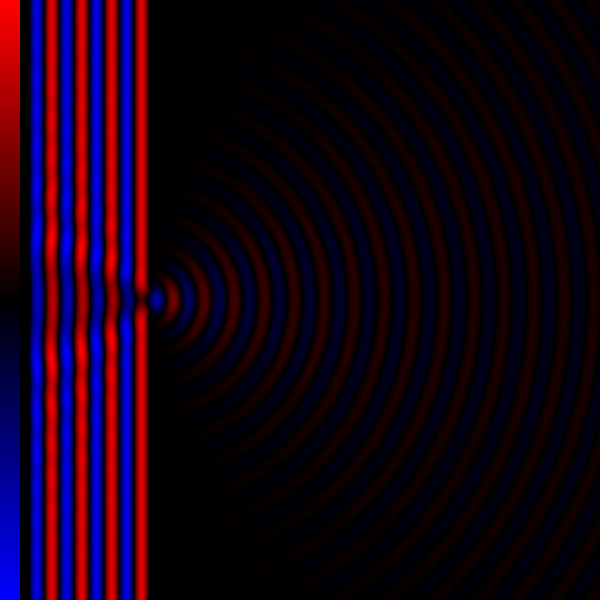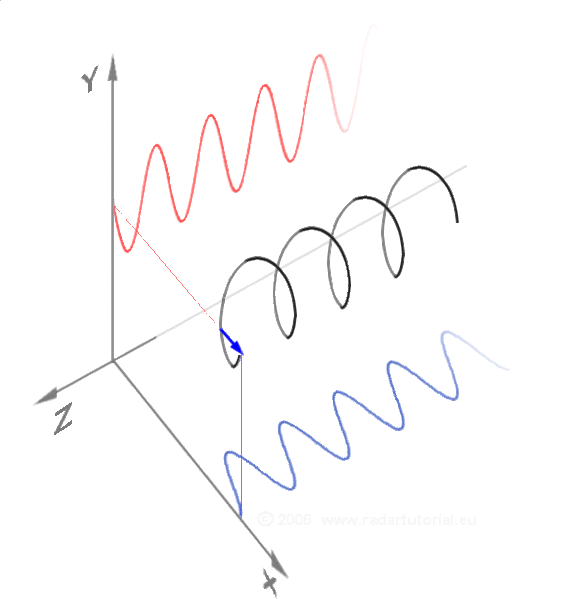The principles of interference, diffraction and polarization of light
The waves emitted by two sources near each other will at some points in the neighbourhood assist each other and at other points destroy each other. Thus there will be points of great disturbance and also points of small or zero disturbance and this process is called interference.
The pattern will be stationary if the frequencies of the sources are identical, otherwise the pattern will change so rapidly that no meaningful study can be undertaken. Interference can occur by the interaction of mechanical waves such as sound and water waves as well as by the interaction of electromagnetic waves such as light and radio waves.

Wikimedia commons: Wave interference
DIFFRACTION
The most conspicuous feature of diffraction is the deviation from rectilinear propagation when a wave is obstructed by an opaque obstacle. The incident waves appear to bend round the obstacle and form fringe patterns in the region of geometrical shadow. Similarly, waves going though transparent hole in an opaque object are spread out in the region of the geometrical shadow. The obstacle in a transparent medium and the aperture in an opaque object are called diffraction centers.
The phenomenon is like that of interference, each resulting from the superposition of several wavelets. The observed diffraction events are due to forced vibration of parts of the diffraction centers at the wave frequency, the production of new waves by these shaken parts, and the superposition of the new waves and the incident waves to give rise to the diffracted wave. Diffraction also confirmed the wave nature of light and of electrons and other material particles.
Huygens-Fresnel principle is used to analyse diffraction problems and it states
Every point on a wavefront serves as a source of spherical secondary wavelets of the same frequency as the primary wave. The optical field at any point beyond an obstruction is the superposition of all such wavelets reaching that point.
The diffraction effects are large when the dimensions of the diffraction centers are comparable with the wavelength of the waves involved. Consequently, diffraction sets a limit to the precision with which light or other waves can be used to record the fine detail in a physical object being examine. Thus the dimensions of an object can be very precisely measured in terms of the wavelength of the diffracted waves such as light, X-ray, or de Broglie waves of electrons.
On the other hand, diffraction effects are not observable when the wavelength of the waves is much smaller than the dimension of the diffraction centers. Diffraction limits the sharpness of the images produced by optical instruments. However, the shorter the wavelength of the waves and the larger the diameter of the lens or mirror in an optical instrument, the less significant the diffraction effect.

Wikipedia commons: wave slit diffraction
POLARIZATION
Interference and diffraction can occur with all kinds of waves including sound and surface waves in a liquid as well as electromagnetic waves. That is, both transverse and longitudinal waves. Polarization occurs only with transverse waves; the phenomenon has therefore been used as such to establish the transverse nature of light and electromagnetic waves in general.
Electromagnetic waves such as light waves consist of electric and magnetic fields which are perpendicular to the direction of the wave and to each other. The direction and plane of polarization of an electromagnetic wave are respectively the direction and plane of its electric field. For plane polarized light wave, e.g it'd electric field oscillates within a single plane and traces a sinusoidal curve along the direction of propagation.

Image source: Wikimedia commons
PRODUCTION OF POLARIZED LIGHT
The light from ordinary sources like sun or fluorescent lamp is unpolarized. This means that the planes of vibration are randomly oriented about the direction of propagation. Polarized light can be obtained by interposing a polarizer e.g Polaroid in the path of the light.
According to Newton's corpuscular theory of light, light energy was propagated by particles of matter corpuscles emanating from luminous objects. It was the era of mechanical models and so it was assumed that these small particles obeyed the laws of mechanics and produced the sensation of light when they struck the eye. Although this theory was able to explain reflection of light, it predicted that light should travel faster in denser media, contrary to subsequent experimental results.
Einstein(1905) improved on the corpuscular theory by postulating that instead of a continuous stream of particles, light energy is carried from place to place in the form of tiny discrete bundles of energy called photons of energy E = hf where f is frequency and h Planck's constant. This photon theory of radiation has been used in successfully explaining some physical phenomena e.g photoelectric effect and Compton effect. However phenomena like interference, diffraction and polarization which are easily explained using the particle theory. This means that light manifests as particle or wave depending on the circumstances, never as both wave particle in any one situation. Light or radiation has dual character and is called wave particle duality.
According to Louis de Broglie (1924) this dual character applies not only to radiation but to all fundamental entities of physic. This is the de Broglie hypothesis.
CONCLUSION
Interference occurs if the path difference of two coherent sources is a whole number of wavelengths. When a thin wedge is illuminated by a parallel beam of monochromatic light the interference pattern is a series of alternate straight bright and dark bands running parallel to the line of intersection of the two planes forming the wedge. Polarized light can be produced by means of a polarizer, also by reflection. The reflected light is fully polarised in brewster's law is satisfied.
Light exhibits wave particle duality. According to the de Broglie hypothesis this dual character is exhibited by all fundamental entities of physics.
REFERENCES
- Diffraction
- Corpuscular theory of light
- Polarization (waves)
- Different Methods for Production of Polarised Light
- Wave interference
